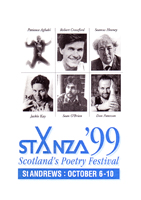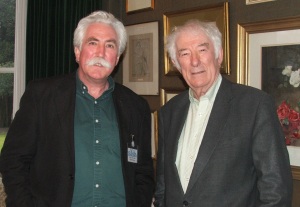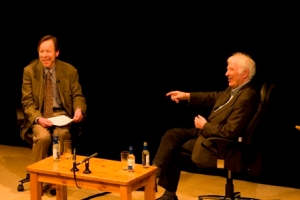A personal reminiscence by Brian Johnstone, former Festival Director
In his funeral tribute to Seamus Heaney, Paul Muldoon talked about how everyone in the poetry community has been devastated by our sudden loss. Muldoon went on to describe Seamus’s “signal ability to make each of us feel connected not only to him but to one another.” So in this small remembrance of his connections to StAnza, and to me through my work for the festival, I can only call him Seamus. To address him as Heaney seems too impersonal for such a generous and gregarious man. Although I only met him a few times, and attended no more than half a dozen of his appearances, my feelings tell me that I have lost a friend – a friend whose poetry has inspired me in my own writing, but also a man who made me feel he was a friend and supporter of all I tried to do with StAnza – someone who encouraged me in both of these endeavours whenever we met.
 Seamus’s first appearance at StAnza was in 1999 – only the second festival, so we were aiming high even in those days. Through the support of the University School of English we were able, despite being a very young festival, to feature him on the bill. Seamus appeared on the Thursday night in the Buchanan Theatre – our subsequent main venue The Byre not having been built by then – taking the stage for a two part reading. In the first half he read from his various collections and in the second from his recently published translation of Beowulf. Needless to say, the event was wonderful and very well received by a capacity audience.
Seamus’s first appearance at StAnza was in 1999 – only the second festival, so we were aiming high even in those days. Through the support of the University School of English we were able, despite being a very young festival, to feature him on the bill. Seamus appeared on the Thursday night in the Buchanan Theatre – our subsequent main venue The Byre not having been built by then – taking the stage for a two part reading. In the first half he read from his various collections and in the second from his recently published translation of Beowulf. Needless to say, the event was wonderful and very well received by a capacity audience.
I had actually first come across Seamus in performance at an event held as part of the Edinburgh Festival Fringe some years before. Watching the funeral online brought back powerful memories of this first experience. Playing at various points during the service was the uilleann piper Liam O’Flynn, with whom Seamus had performed at that Fringe event years back. Sitting side by side on the Assembly Rooms stage in front of a large audience doesn’t sound like the best way to achieve a close rapport with those listening, but so focused were the two that the experience was one of extreme intimacy. I felt as if I had been sitting at their fireside in rapt attention as the poet and piper swapped verses and tunes. It was my first encounter with Seamus Heaney and it is one I will never forget.
It is this very sense of intimacy that Seamus was so adept at putting over to his audience, and which was characteristic of his subsequent appearances at StAnza. At that first one in the Buchanan Theatre, however, I only got to meet him very briefly because of his other commitments. I managed to shake him by the hand and thank him for his reading, and that was it. But this was enough for him to remember me when next we met, despite the hundreds of people he must have met in all his travels. This was in London at the British Library when I was representing StAnza at the 2005 launch of The Poetry Archive website. Seamus was the guest reader at this event and I was astonished to discover that he not only remembered me but was even happy to have a chat for ten minutes or so. We had bit of craic about the great Scottish poet – and mutual favourite – Norman MacCaig and I was able to personally invite Seamus back to St Andrews for a future festival. He was glad to accept, and we subsequently agreed on him topping the bill for the 10th festival in 2007. But I would be in his company again before then.
In the summer of 2006, Seamus gave a superb reading at the Edinburgh International Book Festival and I was fortunate to be invited to the reception held in his honour at the Irish Consulate. As always, Seamus was feted by a large crowd, but the reception gave me another chance to have a friendly chat with  the poet and an opportunity to meet his wife Marie. I remember him reiterating his real fondness for St Andrews and for Scotland in general and my saying how much we were looking forward to welcoming him to StAnza the following March. Sadly, that was not to be.
the poet and an opportunity to meet his wife Marie. I remember him reiterating his real fondness for St Andrews and for Scotland in general and my saying how much we were looking forward to welcoming him to StAnza the following March. Sadly, that was not to be.
I was on holiday in France later that summer when I had a call from Eleanor Livingstone, then StAnza’s Artistic Director. The news was bad. Seamus had had a stroke and was in hospital. His doctors had advised him – ordered, more like – to cancel all engagements for the next year at least. All I could do was ask Eleanor to pass on my sympathies to Seamus’s family, with whom we were in touch through a mutual friend, and start thinking about who we could book as a replacement.
Back home, meeting Eleanor to discuss this, she told me about an extraordinary phone call she had had while I was still on holiday. If proof were needed – which it’s not – of Seamus’s extraordinary character, this is it. Having been unable to get any definite information, Eleanor called the mobile number Seamus had given us. The following day Seamus, having noticed her missed calls, phoned back. He was, he told her, still in hospital but he wanted to apologise to StAnza for letting us down!
Thankfully, Seamus recovered from that bout of ill health and by the next year was ready to discuss honouring his promise to come back to StAnza. While he explained that he wouldn’t be able to be at StAnza in the immediate future, he wanted to be clear – more generosity – that he hadn’t forgotten his promise. And so he was booked to appear in 2010, the last StAnza for which I was Festival Director. For me personally, this was a wonderful coup and for our audiences it meant that my stepping down would be marked with the biggest name possible. I was – am – so grateful to Seamus for that.
Working together on festival planning, Eleanor and I managed to programme not one but three separate events featuring Seamus. A full main stage reading, of course; but Seamus was also willing to give a round table reading, one of StAnza’s signature intimate readings for only a dozen or so people; on top of that, we arranged for him to take part in an In Conversation with Dennis O’Driscoll (sadly also recently departed). A bumper appearance indeed!
 I have a very special personal memento of my last festival as a director – and all down to Seamus. Naturally, I asked him to sign a few of his collections for me, one of these being my long-term favourite Station Island. The original Faber publication of this features on the cover and title page what looks like an illustration from an ancient Irish manuscript. This Seamus deftly altered adding speech bubbles to mark my departure from StAnza, but my continued commitment to the stanzas of my own poetry. It’s just such a quirky and amusing bit of personal response – I will treasure it always.
I have a very special personal memento of my last festival as a director – and all down to Seamus. Naturally, I asked him to sign a few of his collections for me, one of these being my long-term favourite Station Island. The original Faber publication of this features on the cover and title page what looks like an illustration from an ancient Irish manuscript. This Seamus deftly altered adding speech bubbles to mark my departure from StAnza, but my continued commitment to the stanzas of my own poetry. It’s just such a quirky and amusing bit of personal response – I will treasure it always.
Both the main stage reading and the In Conversation were sold out in record time and in the end we had to relay both events to the Byre studio and conference room for overspill audiences whom Seamus surprised by dropping in on them unexpectedly during the interval. Again, generous to a fault. Other visiting poets were crammed into every available corner of the theatre, just to ensure they caught the events. In the end, the audiences for both main events were at full capacity in the main theatre, and overflowing to not one but two additional venues. The audiences for both main events were well in excess of the actual capacity of their original venues!
But for me, the true highlight of Seamus’s last StAnza appearance was his round table reading. At that he surprised all present by producing photocopies of a series of new, unpublished poems and passing them round the table. These he proceeded to read and then – more astonishing yet – to more or less ask the audience for a crit. We could scarcely believe that we were sitting round a table with someone of Seamus Heaney’s stature and he was asking us what we though of his new work. Generous again, and inclusive in a way that, as Paul Muldoon said, made us all feel so connected to him and, through him, to each other.
There is little more I can say except that, while I owe StAnza so much, and through it have met numerous poets whose work I love and admire, being able to meet and share some small bits of time with Seamus Heaney is one of the things I feel absolutely the most grateful for. As the poet Jo Bell said so eloquently in her tribute to Seamus, “Poetry stands for love. Those whom we remember are the ones who said most clearly, that which we are trying every day to say.”
Brian Johnstone
9th September 2013
StAnza ’99 programme:
http://issuu.com/stanza/docs/1999?e=1457317/3190480
StAnza 2010 programme:
http://issuu.com/stanza/docs/stanza10-final?e=1457317/3187815
2010 photo gallery:
http://stanzapoetry.org/2010/photo-gallery10.php
Tags: Brian Johnstone, Dennis O'Driscoll, Irish Consulate, Irish poetry, Jo Bell, Paul Muldoon, School of English at St Andrews, Seamus Heaney, St Andrews, StAnza: Scotland's International Poetry Festival, the University of St Andrews
 I am from Asheville, North Carolina, a hippie town in the middle of the Bible Belt of the Appalachian Mountains–the prettiest place on earth! I work for a charity doing social entrepreneurship, and spend my days talking to social visionaries about how they are changing the world and how they got to be the way they are–a privilege. I have lived in Dublin for the past four and a half years.
I am from Asheville, North Carolina, a hippie town in the middle of the Bible Belt of the Appalachian Mountains–the prettiest place on earth! I work for a charity doing social entrepreneurship, and spend my days talking to social visionaries about how they are changing the world and how they got to be the way they are–a privilege. I have lived in Dublin for the past four and a half years.







